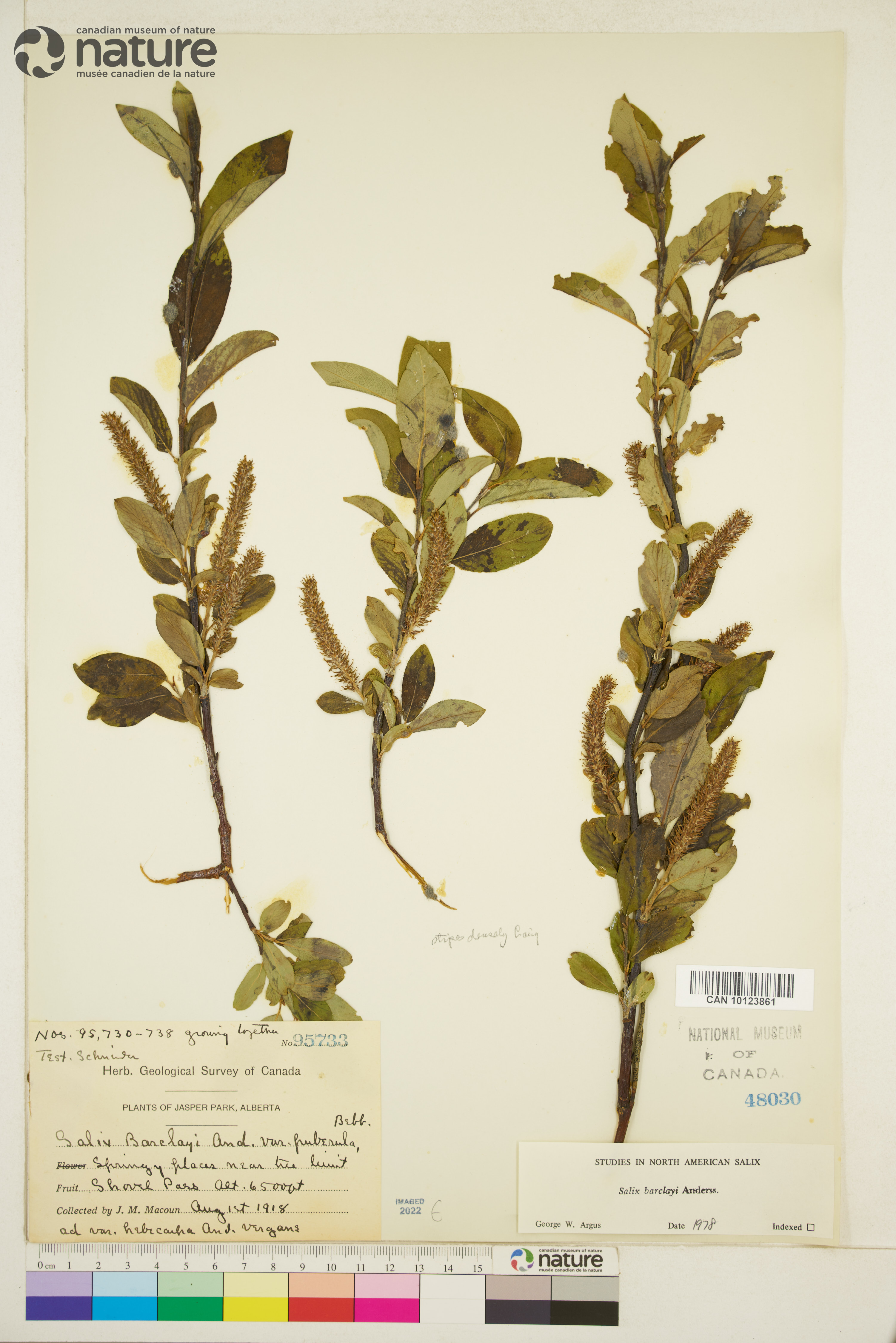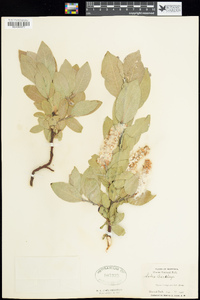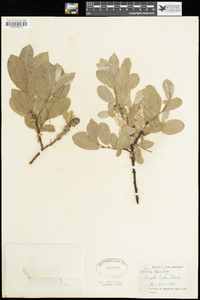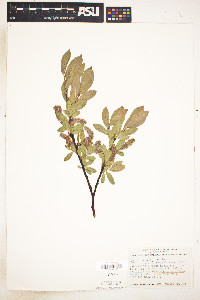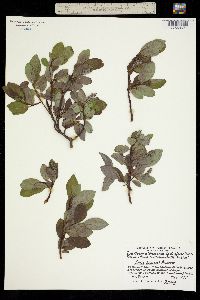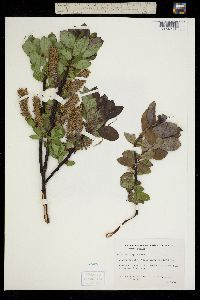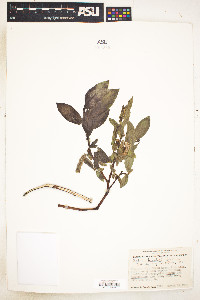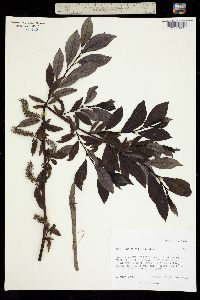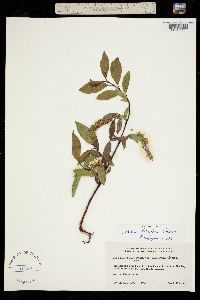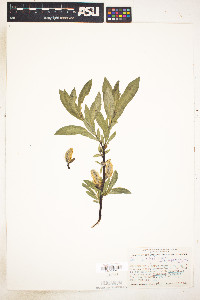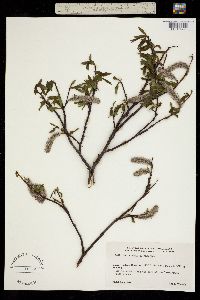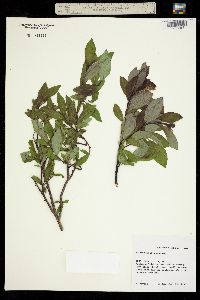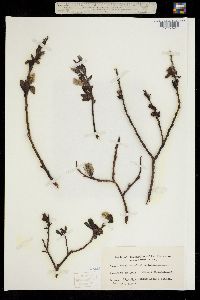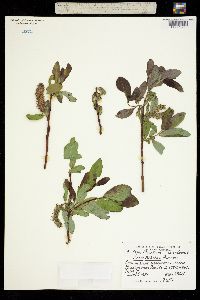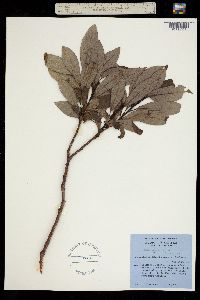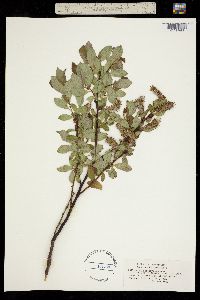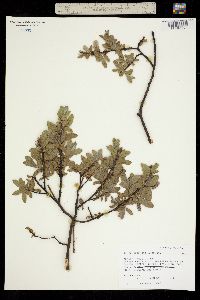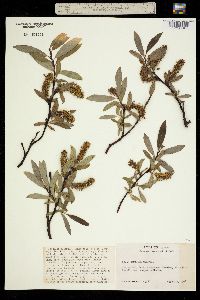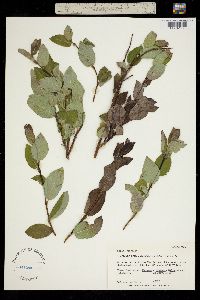Salix barclayi
|
|
|
|
Family: Salicaceae
Barclay's Willow
[Salix barclayi var. angustifolia, moreSalix barclayi var. conjuncta , Salix barclayi var. rotundifolia Andersson, Salix conjuncta Bebb, Salix hoyeriana Dieck ex Dippel, Salix pyrolifolia var. hoyeriana , Salix regelii Anderss.] |
Plants (0.3-)1-3(-5) m. Stems: branches usually red-brown, sometimes yellow-brown, not to strongly glaucous, glabrous or villous; branchlets yellow-green, yellow-brown, or red-brown, densely villous to pubescent, (buds caprea-type, inner membranaceous bud-scale layer free, separating from outer layer). Leaves: stipules foliaceous, (2-14 mm), apex rounded or acuminate; petiole shallowly grooved, or convex to flat adaxially, 3-14(-20) mm, villous or pilose adaxially; largest medial blade oblong, narrowly elliptic, elliptic, oblanceolate, or obovate, 33-70(-100) × 12-35(-48) mm, 1.6-2.8(-4) times as long as wide, base usually rounded or convex, sometimes subcordate, margins slightly revolute or flat, serrulate, apex acute, acuminate, or convex, abaxial surface glaucous, glabrous or glabrescent, hairs straight, adaxial slightly glossy or dull, glabrous or pilose, midrib pilose; proximal blade margins serrulate or entire; juvenile blade sometimes reddish, densely villous or glabrous abaxially, hairs white. Catkins flowering as leaves emerge; staminate stout, 13-60 × 10-25 mm, flowering branchlet 0-17 mm; pistillate moderately densely flowered, stout, subglobose, or slender, 26-80 × 9-18 mm, flowering branchlet 4-24 mm; floral bract brown or black, 1.6-2.8 mm, apex acute or rounded, abaxially hairy, hairs straight, wavy, or curly. Staminate flowers: adaxial nectary oblong, 0.5-1 mm; filaments distinct, glabrous; anthers yellow, 0.6-1 mm. Pistillate flowers: adaxial nectary oblong or ovate, 0.4-0.8 mm, shorter than or equal to stipe; stipe 0.4-1.5 mm; ovary obclavate or pyriform, glabrous, beak gradually tapering to styles; ovules 18-24 per ovary; styles 0.6-2.5 mm; stigmas slenderly cylindrical, 0.28-0.48-0.72 mm. Capsules 3-8 mm. 2n = 76 (based on putative Salix barclayi × S. barrattiana, see below). Flowering late May-early Aug. Lake and streamshores, fens, moist to mesic forest openings, subalpine and alpine slopes, glacial moraines; 0-2800 m; Alta., B.C., N.W.T., Yukon; Alaska, Idaho, Mont., Oreg., Wash., Wyo. Vegetative specimens of Salix hastata often are misidentified as S. barclayi. The characters that indicate S. hastata, or sometimes possible hybrids, are the presence of ferruginous hairs on juvenile leaves or adaxial midribs of mature leaves, leaf margins often entire or with teeth present only distally, and buds with inner membranaceous layer not separating from outer layer. Salix barclayi is distinguished from S. farriae and S. hastata by having bud-scales with inner membranaceous layer separating from outer layer, juvenile blades glabrous, pilose, or moderately densely villous, largest medial blades oblong, narrowly elliptic, elliptic, oblanceolate, or obovate, margins always toothed, pistillate flowering branchlets 4-24 mm, staminate flowering branchlets 0-17 mm, floral bracts brown to black, moderately densely hairy, anthers 0.6-1 mm, styles 0.6-2.5 mm, and stipes 0.4-1.5 mm; S. farriae has bud-scales with inner membranaceous layer separating from outer layer, juvenile blades glabrous or sparsely villous, largest medial blades narrowly elliptic to elliptic, margins usually entire, pistillate flowering branchlets 1.5-14 mm, staminate flowering branchlets 1-5 mm, floral bracts bicolor, brown, or black, sparsely hairy, anthers 0.3-0.6 mm, styles 0.3-1.2 mm, and stipes 0.5-1.2 mm; and S. hastata has bud-scales with inner membranaceous layer not separating from outer layer, juvenile blades sparsely pubescent, largest medial blades narrowly to broadly elliptic, narrowly ovate, or ovate, margins usually entire, pistillate flowering branchlets 1.5-9 mm, staminate flowering branchlets 1-7 mm, floral bracts brown or bicolor, sparsely hairy, anthers 0.4-0.6 mm, styles 0.2-0.48 mm, and stipes 0.4-1.2 mm. Hybrids: Salix barclayi is morphologically highly variable. While it is possible that much of this variability is inherent, hybridization and introgression have played an important role. Salix barclayi forms natural hybrids with S. arctica, S. barrattiana, S. brachycarpa, S. cascadensis, S. commutata, S. farriae, S. hastata, S. hookeriana, S. richardsonii, and S. stolonifera. Salix barclayi × S. barrattiana is characterized by oily buds that stain the pressing paper yellow, and leaves often entire, or nearly so, and closely gland-dotted, and not glaucous abaxially. Some hybrids resemble S. barclayi in having ovaries glabrous an |

